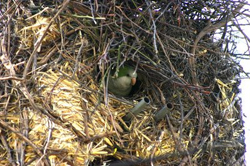| Monk
parakeets that have returned to the wild are causing problems for
utility companies.
by Elizabeth Quinn
 Photo courtesy
of Steve Baldwin
Photo courtesy
of Steve Baldwin
Monk parakeets
are highly social and are now part of the natural environment
in many states.
|
|
Since 1970, New York City has been
home to a different species of immigrant: the monk parakeet. Usually
a common sight in pet stores, these birds started being spotted
around the city and now Brooklyn is home to the largest population.
For the residents, they are an exotic addition to the natural environment,
but the utility companies have deemed them a nuisance since their
huge nests, often built on electrical poles, can catch on fire or
cause blackouts if they are built too close to a transformer. In
some states, the problem is dealt with by killing the parakeets,
but in New York, some people are trying to find a less drastic solution.
Dr Eleanor Miele, a professor of elementary
science and environmental education at Brooklyn College, has been
studying the monk parakeets in the area for the past seven years.
They are native to Argentina and Brazil and she believes that the
majority of these birds were introduced to the New York City environment
when a shipment of parakeets being sent out of the country was accidentally
released in 1967. A small percentage of the parakeets are former
pets that escaped or were released and joined this main group. Parakeets
typically live about 30 years and Miele claims that some of the
birds now living around the college are from the original flock.
Although monk parakeets are small birds, on average 29 cm long, their nests are hard to miss. They can be quite monstrous, sometimes reaching the size of a small car and weighing up to 2,000 pounds. Parakeets are highly social and live in colonies where up to 200 couples can share the same nest with separate entrances for each pair. Each couple's "apartment" is quite sophisticated and contains an area for laying and incubating eggs, a living area for the hatched chicks and a lookout point for the parents to guard the nest. Among parrots, they are the only species to even make a nest since other species simply find a hole to lay and incubate their eggs.
 Photo courtesy
of Steve Baldwin
Photo courtesy
of Steve Baldwin
Monk parakeet
nests can weigh up to 2,000 pounds.
|
It is obvious that the size and weight of parakeet nests can make them highly destructive. In Connecticut, monk parakeets are blamed for having caused about a dozen power outages per year and four fires in the past four years. In December 2005, United Illuminating, the electric power company, used nets to trap parakeets living in 103 nests on power poles and turned them over to the U.S. Department of Agriculture where they were gassed with carbon dioxide. In Brooklyn, Consolidated Edison is responsible for electric power and they have been removing the nests without capturing the birds. However, this has to be done periodically and isn't a permanent solution to the problem.
According to Miele, there are better ways to deal with the nests without harming the parakeets. One option is to create a barrier around areas where they would cause serious damage or putting platforms on the poles so that the birds could make their nests away from the transformers. Having lower wires is also a possible solution since the parakeets are capable of building nests in trees, but choose the electrical wires as an alternative when they are high up.
In Florida, people have managed to trap wild parakeets and return them to the pet trade, but Miele does not think they need to be removed from natural environments. "It's a natural process, so unless there is a hazard to human health, I prefer to let nature take its course," she says. When parakeets are kept in captivity they are not as healthy, nor as brightly-colored and vigorous, as when they're in nature.
Other conservationists are in favour of a more creative solution to the nesting problem: the "monk bunker". Designed by Marc Johnson from Connecticut, it's a free-standing polyvinyl chloride pipe that can be inserted into the ground and has a multi-chambered wooden box attached to it. Chicken wire and twigs are wrapped around the box which the birds can add to to make their nests. These structures can be installed on private properties for the birds to nest in, detracting them from the power lines. The first monk bunker was tested in the garden of Julie Cook, a woman who was arrested last December for protesting against the killing of the parakeets in Connecticut. It proved to be successful and many parakeets are now nesting there.
 Photo courtesy
of Steve Baldwin
Photo courtesy
of Steve Baldwin
Monk bunkers
in construction: these structures could be a good alternative
for nesting parakeets.
|
Although they are not yet widely available
to the public, monk bunkers are expected to be marketed soon on
the web site monkbunkers.com. Steve Baldwin, a resident of Brooklyn
and parakeet enthusiast, has already attended a grassroots session
in his area to help build the nesting structures. He hopes to help
Johnson develop an e-book that will be distributed free online about
how to build a wild monk parrot nest. "We've proven there's a humane
way of getting them off the electrical infrastructure. We have done
what the scientific community has not" Baldwin says.
For more info:
BrooklynParrots.com: A Web Site About the Wild Parrots of Brooklyn
http://www.brooklynparrots.com/
Monk Parakeets at Brooklyn College
http://academic.brooklyn.cuny.edu/education/miele/fieldinv.htm
|
